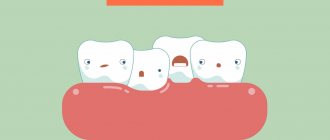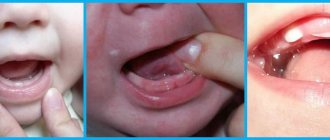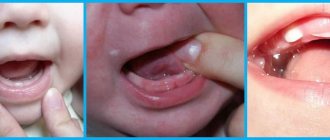- Crooked teeth
- The appearance of a second row of teeth in the jaw
- When permanent teeth do not appear for a long time
- How to distinguish baby teeth from permanent ones?
The complex process of replacing baby teeth with permanent ones is often painful and accompanied by a number of problems. The most common of them is malocclusion. The second most common problem is the appearance of a second set of teeth. Also, many parents are faced with the fact that their child’s molars and incisors do not appear for a very long time.
Crooked teeth
If permanent teeth begin to grow unevenly, you need to come for a consultation with an orthodontist at the A-Medic Network of Medical Clinics as soon as possible. The sooner such a decision is made, the easier it will be for the dentist to correct their growth. An incorrect bite is not only inconvenient, it can lead to the development of a number of diseases, for example, caries, stomach diseases, and cause childhood and teenage complexes and psychological problems.
The easiest way to straighten your jaw is to wear braces. It is very important for parents, together with the attending physician, to explain to the child that temporary inconveniences when using braces are justified and will bring invaluable benefits in the future. You need to take good care of it, because it will stay in your mouth for at least six months. This design will work most effectively during adolescence. Small children can more easily tolerate plates or trainers, which look something like boxing mouthguards, rather than braces. Children's enamel is quite delicate, so trainers that do not damage it will be the best way to correct a child's malocclusion.
If the tooth has not grown, we will pull it out
IF THE TOOTH HAS NOT GROWN, WE WILL PULL IT OUT
An orthodontist is a doctor who is especially popular today not only among children, but also among adults. It is relatively easy for children to straighten their teeth while the jaw bones are still young and pliable. But in adults, bite treatment is no longer a problem. Most often, orthodontic treatment is required when a person decides to undergo prosthetics. He comes, as expected, to the orthopedist, and he is immediately referred to the orthodontist. There are several reasons for this,” says medical orthodontist Roman Labzin.
One of the reasons is that there is not enough space in the mouth for dentures, which means that the dentition needs to be moved apart. Crowded teeth also require correction of their position. In general, an orthodontist is the first doctor who prepares the mouth for prosthetics.
Or could it happen that after visiting the orthodontist, you won’t need prosthetics? Will all teeth fall into place or will they successfully take someone else’s teeth?
Through orthodontic treatment, it is actually possible to replace missing teeth and do without prosthetics. For example, a patient once had his lower sixth teeth removed. He is faced with a choice - either to install an implant at great expense and cover it with a crown, or... to move nearby teeth. Typically, such people have problems with their bite and teeth alignment. By correcting the bite, I can close the gap of the extracted tooth - that is, kill two birds with one stone.
Some kind of “epidemic” has begun with malocclusions - you walk around the city and see almost every second person has braces on their teeth, and, surprisingly, in adults.
And this is not surprising. It is adults who most often turn to the orthodontist due to malocclusion. This problem actually occurs in every second person. The bad habits that adults instill in children, starting from infancy, play a detrimental role in this. For example, the habit of using a pacifier. I had a girl who did not take the pacifier out of her mouth until she was six years old. And as they get older, children begin to eat incorrectly—swallowing food, chewing it poorly. Apparently, looking at adults who are always in a hurry somewhere. Due to products that are already sold in a “chewed” state - yoghurts, muesli, baby purees, children and teenagers no longer need to chew, therefore teeth do not grow, jaws do not change and an anomaly is formed. Add here pathologies from the nasal cavity - adenoids, which in our humid climate develop in almost all children, and you get another reason for improper development of the jaw.
How exactly do adenoids affect teeth?
Due to adenoids, nasal breathing is impaired, and the child constantly breathes through the mouth. His lower jaw droops, and his upper jaw becomes very narrow, so there is not enough space for all his teeth, and they grow, overlapping each other. There are many reasons for the development of malocclusion. The most important function of teeth is chewing, so chewing is essential for both children and adults.
And if an adult has nothing to chew, is it not harmful for him to go without teeth for years?
Of course, it is harmful, now for the gastrointestinal tract, since undigested food causes gastritis and ulcers. In addition, ten years after losing teeth, such deformations will occur in the oral cavity that it will be very difficult to restore a normal bite. Rational prosthetics must be done on time.
How long after root removal do I have to wait before getting prosthetics?
It is better to do this within six months, or at most, up to a year.
How does your bite change with age?
First of all, the depth of the bite changes. While eating, the teeth rub against each other and gradually wear down and decrease in height. Such physiological wear of teeth over the years can significantly shorten them and lead to periodontitis. When this process occurs too quickly, pathological tooth wear develops, which causes a deep bite. A deep bite is a jaw condition in which the upper teeth overlap the lower teeth by more than one-third of the incisor crowns.
So, you should nibble on carrots while you’re young, and switch to more gentle food as you get older?
Of course, after 50 years it is better to take care of your teeth. Moreover, if the teeth wear evenly, the orthodontist will not help. Then it is better to contact an orthopedist, who can prevent further tooth wear by placing crowns on them.
What other bite pathologies are there?
Medial bite – when the lower jaw protrudes and the lower teeth protrude above the upper teeth. This pathology does not give a very aesthetic appearance to the face, but it is most often congenital and genetically inherited. Orthodontic treatment will not help here; maxillofacial surgery is necessary.
Changing the bite does not have a very good effect on appearance...
Yes, a decrease in bite height due to tooth wear leads to a visual reduction in the lower third of the face and a deepening of the nasolabial fold. Of course, this ages the face. Therefore, dental prosthetics and, accordingly, orthodontic treatment should be carried out in due time.
Until what age can a bite be cured?
One client I gave braces to was 58 years old. She had an impacted canine - a tooth that had formed at one time, but never erupted. Many years ago, the dentist apparently did not notice it, and when her baby tooth fell out, he gave her a denture, which she wore all her life. And we carried out orthodontic treatment and pulled this canine out. Now she has her own real tooth.
How often do such situations occur?
I have several patients with impacted fangs, some have one tooth left in the bone, others have both. Quite often the upper incisors fail to grow in, this happens for various reasons. One of the most common is the removal of baby teeth in early childhood. It very rarely happens the other way around. Milk teeth are retained until a person is 25 years of age or older. And the permanent tooth not only does not grow, but is completely absent from the bone. Then you have to place an implant and also carry out orthodontic treatment. Braces are the most popular type of correction among people. And when they do not help, then you have to resort to other structures, including removable ones. There are many treatment methods, of which I choose only those that are suitable for a particular person with his bite and problems.
What are the main indications for treatment by an orthodontist?
The main indication is teeth that are incorrectly positioned or grown in the wrong place. Of course, a greatly altered bite, which we have already talked about. Small changes in the bite are difficult for a person to determine on their own, so it would not hurt for every person to come for a consultation with an orthopedist at least once.
You can go to the orthodontics section at the multidisciplinary clinic “Panorama Med” here .
To make an appointment with an orthodontist, call: +7 (812) 244-90-10 and 8 (812) 970-00-70
The appearance of a second row of teeth in the jaw
Each canine, incisor and molar has its own place, but sometimes a child's permanent teeth begin to form a second row. This often happens when the milky ones have not yet fallen out, but the radical ones have already begun to appear. An undeveloped jaw that provides too little room for growth can also be a source of the problem. The third reason is that the incisors and canines in the second row are “superfluous”, or supernumerary.
The second row of teeth is not only inconvenient, but also unsightly, so the problem needs to be solved. A baby tooth that does not fall out in time can be removed in the clinic. If the reason for the formation of the second row is underdevelopment of the jaw, then the dentist can remove several teeth and install braces on the remaining ones.
Reasons for retention
Most often, the reason for the development of retention is associated with the incorrect location of neighboring teeth, which become an obstacle to the eruption of retention teeth. In other cases, the problem may be due to too dense bone or gum tissue.
Other factors influencing the development of pathology include the following phenomena:
- supernumerary (abnormally large number of teeth),
- diseases of internal organs, which leads to disruption of the full development of the entire skeletal system,
- loss of baby teeth at too early an age,
- genetic predisposition.
When permanent teeth do not appear for a long time
The absence of permanent teeth for too long can be due to several reasons: these are the genetic characteristics of the body, their immaturity, and the destruction of tooth germs by some kind of infection.
Only a dentist can determine the true cause. At the A-Medic Network of Medical Clinics clinic, they will take a picture of the jaw, which will show how the child’s permanent teeth are formed. Sometimes they can grow inside the gums. If nothing is visible on the image, the doctor may suggest solving the problem by installing dentures.
Typical problems
PHOTO: The child's lower permanent incisors erupted in the second row. In this situation, it is necessary to free up space by removing the mobile baby teeth so that the permanent teeth can take the correct position in the dental arch.
Sometimes the permanent upper and lower incisors erupt behind the primary ones (“second row”), which do not have time to resolve by this time. This situation requires the intervention of a dental surgeon.
Progression of previously formed caries on the teeth, especially in the area of primary chewing teeth.
The eruption of the first permanent molar in conditions of poor individual oral hygiene and the presence of a large number of untreated carious teeth nearby is often accompanied by the development of caries on the erupting young tooth (molar). During the process of eruption, the 6th tooth is partially covered with a mucous membrane, like a hood, under which plaque and food debris become clogged. The carious process in such conditions develops extremely rapidly, often unnoticed by the patient and his parents, and is quickly complicated by inflammation of the nerve of the tooth.
How to distinguish baby teeth from permanent ones?
Both molars and baby teeth have a similar structure, but have a number of external differences.
- Thus, milk ones are on average lighter and whiter than permanent ones, which are distinguished by a yellowish enamel tone.
- On average, a molar is larger than its primary tooth.
- Permanent ones have a thicker layer of hard tissue and a less developed pulp.
- Dairy varieties have thinner and shorter roots.
It is important for all parents to remember that both baby and permanent teeth of children must be protected, and any problems that arise in their growth and development must be resolved immediately. Specialists from the “A-Medic” network of medical clinics can help them with this.
A child’s teeth deteriorate: reasons
The most common problems with children's teeth identified by dentists are:
- the baby’s teeth turn black or the enamel darkens in places;
- the child has fragile teeth, which is why they begin to crumble;
- active development of caries in preschool children.
Let's look at the causes of these key problems and possible ways to solve them.
A child's teeth deteriorate for various reasons. The main ones:
- exposure to aggravating factors during the period of intrauterine development of the fetus (severe and prolonged toxicosis during pregnancy, impaired or insufficient nutrition of the expectant mother, necessary or careless use of certain medications);
- if a baby under the age of one year was given intensive antibiotic therapy;
- insufficient dental care and, as a consequence, the development of early caries;
- insufficient absorption of calcium;
- permanent and persistent dental plaque;
- hereditary predisposition (individual characteristics of enamel);
- limited salivation;
- chronic diseases. For example, gastritis with high acidity makes tooth enamel more susceptible to caries. This is explained by the fact that increased acidity affects the absorption of calcium and phosphorus;
- dysbacteriosis;
- the presence of a large amount of foods and drinks containing sugar in the child’s diet;
- impaired metabolism;
- exchange of bacteria between parents and child (for example, when sharing cutlery);
- unformed children's enamel.
Dark spots on the enamel may indicate that caries has begun to develop. If you start this process, caries will penetrate even deeper into the tooth. Due to the special structure of the pulp, destructive processes spread very quickly: for example, caries can turn into pulpitis in just a few months.
What are shark teeth?
They are talked about when extra units appear in the dentition, that is, a child’s tooth has not had time to fall out, but a molar has already appeared next to it. Then the smile seems strange and looks unaesthetic.
What to do with such a problem? Does she tolerate delays? You can wait no longer than two to three months for the milk root to resolve on its own. During this time, you can try to loosen the extra unit. If the time has come to an end, but the “shark” bite remains, you need to go to the dental clinic. Some parents wait longer, and their situation is resolved in the most favorable way. But such tactics are dangerous.
The fact is that a long stay of the root structure in an incorrect position can lead to malocclusions , which will persist into adulthood. It is important to consider where the “shark neighbors” are. If we are talking about the smile zone, then delay is definitely unacceptable.
If a child’s teeth are spoiling, what to do?
It is important for parents to understand that enamel is the main protection, the stability and structure of which depends on hereditary factors and on the saliva that washes the surface of the teeth. If the composition of saliva is disturbed because the child does not receive enough vital nutrients and minerals, this can lead to the formation of permanent plaque on the teeth. Even with systematic and thorough cleaning, it is impossible to get rid of such plaque forever, since it will appear again and again.
If a child’s teeth deteriorate due to the disturbed composition of saliva, then this problem can be solved by adjusting the diet. The menu should be balanced. It must contain foods rich in iron, calcium and other minerals that strengthen tooth enamel: hard cheese, sesame seeds, bran, feta cheese, milk, cottage cheese, herbs, legumes. Foods rich in phosphorus are very useful: fish, cottage cheese, cod liver, shrimp, squid, beets, carrots.
However, parents’ independent actions cannot always bring results. If your child’s teeth continue to deteriorate, then it is worth making an appointment with a pediatric dentist, who will offer effective treatment methods and help stop the destructive process.
What factors worsen the health of baby teeth?
- Mechanical factors: impacts, bruxism, strong compression. They lead to changes in the tooth and disruption of its integrity.
- Chemical factors: prolonged exposure to sweets on the loose enamel of children's teeth.
- Bacterial factor: the spread of bacteria in the baby’s mouth.
- Sudden temperature changes when eating or drinking.
Is late teething dangerous?
In addition to parents who consider late teething a warning sign, there are others who tend to believe that the later baby teeth appear, the healthier they will be. This is a common myth that has not been supported by science, so you should not believe it.
Too early or late teething or their appearance in an atypical order (outside the pattern) is a reason to see a doctor. Most likely, a diagnosis will be prescribed that will help identify the cause of this developmental feature.
The danger of late teething lies only in possible diseases that occur unnoticed by parents. If experts find out that the reasons for late teething are related to heredity, lack of calcium or vitamin D, there is nothing dangerous about it. In this case, tooth growth is stimulated by changing the diet or prescribing vitamin complexes.
The main thing is for parents to contact a specialist in time to identify a possible disease and treat it as soon as possible.
When is urgent dental care indicated?
Doctors assume that the patient can walk with double units for two to three months. Watchful waiting is suitable if the disorder does not bother the baby and does not cause him significant discomfort. But there are times when it is unacceptable to hesitate. So, it is necessary to get to a dental clinic as soon as possible if:
- There was an unpleasant odor from the mouth. It indicates that the inflammatory process is progressing, and pathogenic microorganisms are actively multiplying in the interdental zone.
- The gums often become inflamed and painful. This occurs due to the pressure exerted by food debris on the delicate mucosal tissues. If the problem is not dealt with in time, inflammation can spread to the roots, and this is very dangerous.
- Pus began to ooze from the problem area. This is an indication for emergency removal of the unit. You cannot wait a day for it to fall out on its own if pus has begun to separate.
- The child cannot eat normally. The unpleasant sensations that occur when food gets into the free space negatively affect the baby’s physical condition and reduce appetite. Without receiving the necessary nutrients, the child becomes lethargic, moody, and loses weight. These sacrifices are not justified. There is an urgent need for dental surgery to remove it.
Also, the wait-and-see scenario is not suitable if the baby is prone to malocclusion (for example, one of his parents wore braces in childhood). Removing the unit will be a good prevention of the development of dental anomalies in adulthood.
Treatment
Unfortunately, there are no conservative ways to solve the described problem. A small patient is indicated for surgical intervention. The doctor will administer an anesthetic, so that further actions will not cause pain. After this, the excess tooth will be carefully removed.
In some cases, doctors themselves tell parents not to rush into vomiting. The dentist's decision is influenced by factors such as:
- location of the unit in a row;
- patient's age;
- features of complaints;
- how long ago the constant change seemed;
- what condition are the temporary roots in and can we count on their rapid self-resorption.
In any case, the final decision should be made by the dentist, not the parents. Therefore, it is imperative to consult a specialist.











